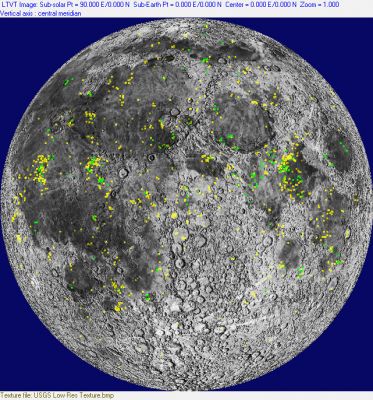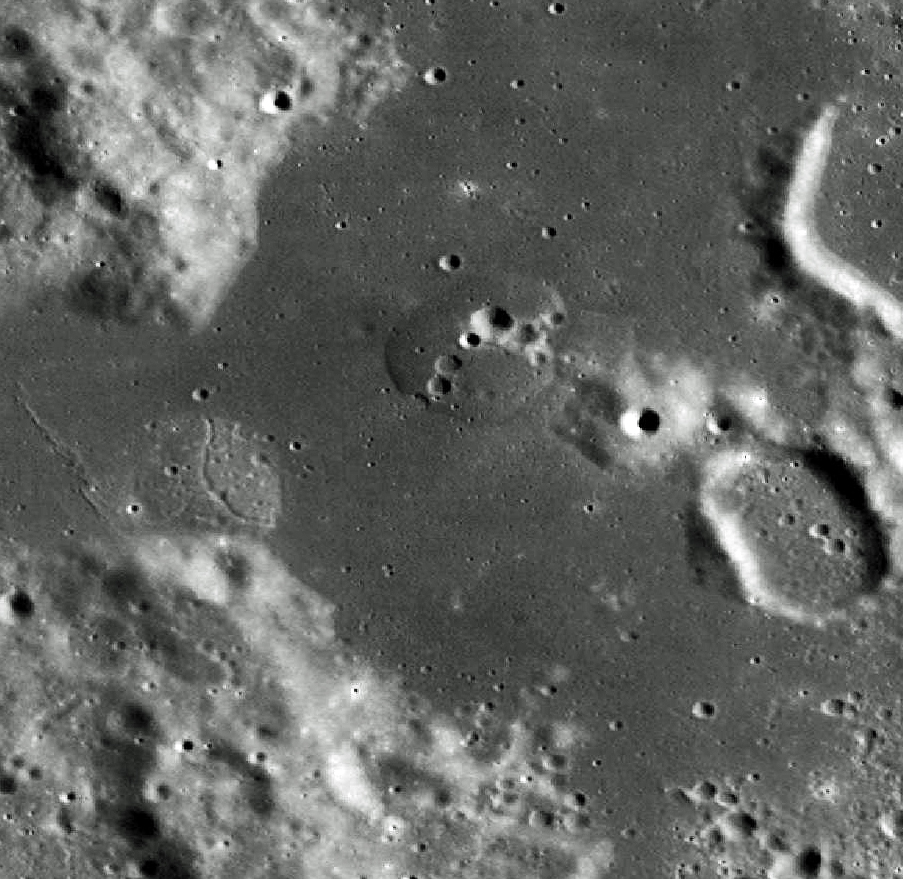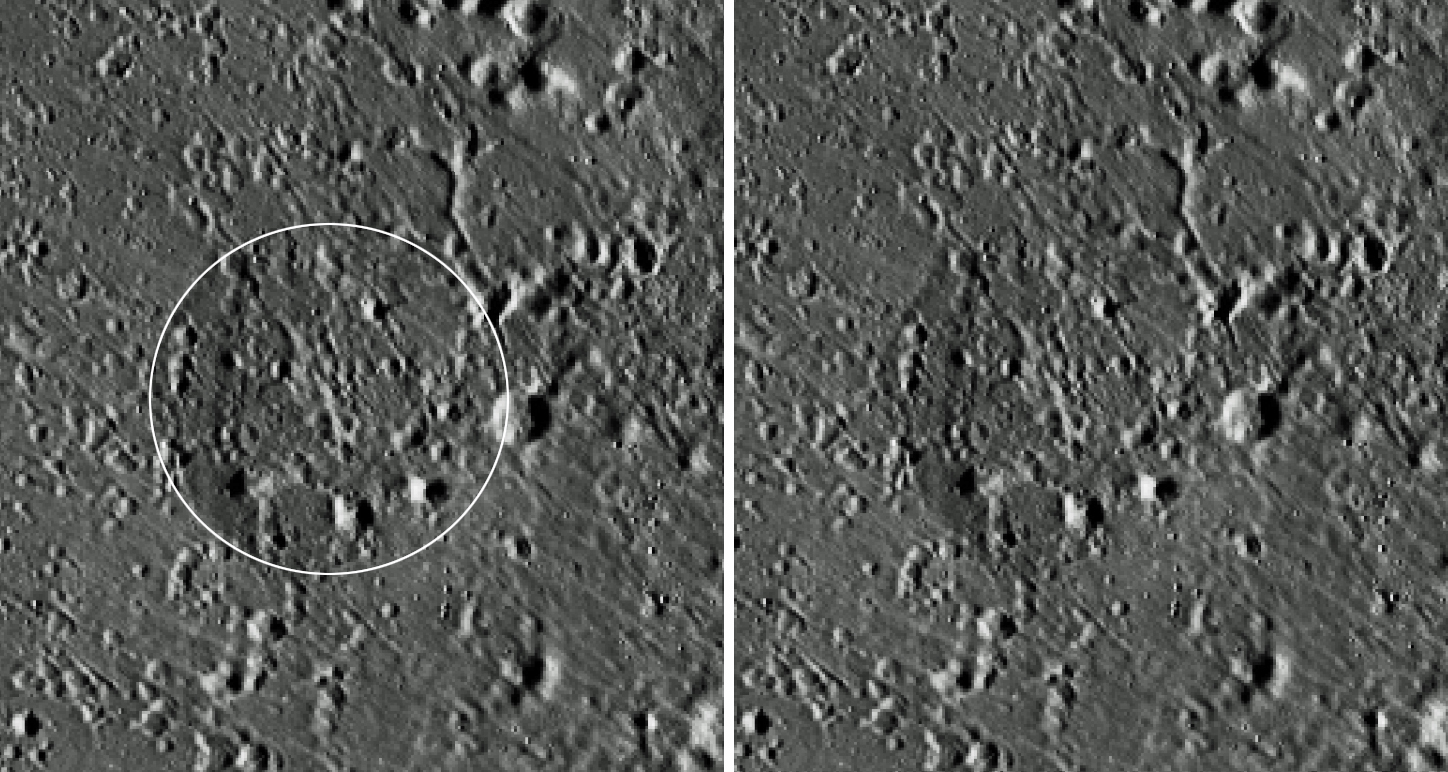Difference between revisions of "Domes"
| Line 12: | Line 12: | ||
[[Image:KeplerDome.jpg|KeplerDome.jpg]]<br /> | [[Image:KeplerDome.jpg|KeplerDome.jpg]]<br /> | ||
|} | |} | ||
| − | '''Left:''' Possible domes east of Oppenheimer H? '''Right:''' Possible dome near [[Kepler|Kepler]]? (see LPOD article - [http://www2.lpod.org/wiki/October_8,_2016 A Dome or No Dome?]) <span class="membersnap">- | + | '''Left:''' Possible domes east of Oppenheimer H? '''Right:''' Possible dome near [[Kepler|Kepler]]? (see LPOD article - [http://www2.lpod.org/wiki/October_8,_2016 A Dome or No Dome?]) <span class="membersnap">- JohnMoore2</span>.<br /> <br /> |
==Domes described in the-Moon Wiki== | ==Domes described in the-Moon Wiki== | ||
[[Arago%20Domes|Arago Alpha]]<br /> [[Arago%20Domes|Arago Beta]]<br /> [[Mons%20Gruithuisen%20Delta|Gruithuisen Delta]]<br /> [[Mons%20Gruithuisen%20Gamma|Gruithuisen Gamma]]<br /> [[Valentine%20Dome|Valentine Dome]]<br /> <br /> | [[Arago%20Domes|Arago Alpha]]<br /> [[Arago%20Domes|Arago Beta]]<br /> [[Mons%20Gruithuisen%20Delta|Gruithuisen Delta]]<br /> [[Mons%20Gruithuisen%20Gamma|Gruithuisen Gamma]]<br /> [[Valentine%20Dome|Valentine Dome]]<br /> <br /> | ||
| Line 24: | Line 24: | ||
''(according to the GLR list, these Greek-lettered peaks are closely related, or identical, to features in that list)''<br /> [[Cauchy|Cauchy]] Omega<br /> [[Cauchy|Cauchy]] Tau<br /> [[Herodotus|Herodotus]] Omega<br /> [[Hortensius|Hortensius]] Sigma<br /> [[Kies|Kies]] Pi<br /> [[Milichius|Milichius Pi]]<br /> ''(there are presumably many more of these, including some corresponding to features in the GLR list, but they are not mentioned there)''<br /> <br /> | ''(according to the GLR list, these Greek-lettered peaks are closely related, or identical, to features in that list)''<br /> [[Cauchy|Cauchy]] Omega<br /> [[Cauchy|Cauchy]] Tau<br /> [[Herodotus|Herodotus]] Omega<br /> [[Hortensius|Hortensius]] Sigma<br /> [[Kies|Kies]] Pi<br /> [[Milichius|Milichius Pi]]<br /> ''(there are presumably many more of these, including some corresponding to features in the GLR list, but they are not mentioned there)''<br /> <br /> | ||
==Other possible domes== | ==Other possible domes== | ||
| − | Very small dome (~0.3 km in diameter) [http://bit.ly/2FbWahr northwest] of crater [[Vitruvius|Vitruvius]] G <span class="membersnap">- | + | Very small dome (~0.3 km in diameter) [http://bit.ly/2FbWahr northwest] of crater [[Vitruvius|Vitruvius]] G <span class="membersnap">- JohnMoore2</span>.<br /> <br /> |
==Additional Information== | ==Additional Information== | ||
* Domes can be produced either by an extrusion of volcanic material onto the surface, similar to [http://en.wikipedia.org/wiki/Shield_volcano shield volcanoes] on Earth ("extrusive comes"); or as the result of an uplifting of the surface due to pressures from magma or chemical changes below the surface, similar to [http://en.wikipedia.org/wiki/Laccolith laccoliths] on Earth ("intrusive domes"). | * Domes can be produced either by an extrusion of volcanic material onto the surface, similar to [http://en.wikipedia.org/wiki/Shield_volcano shield volcanoes] on Earth ("extrusive comes"); or as the result of an uplifting of the surface due to pressures from magma or chemical changes below the surface, similar to [http://en.wikipedia.org/wiki/Laccolith laccoliths] on Earth ("intrusive domes"). | ||
Latest revision as of 20:10, 16 April 2018
Contents
- 1 Domes
- 1.1 Description
- 1.2 Images
- 1.3 Domes described in the-Moon Wiki
- 1.4 Dome fields described in the-Moon Wiki
- 1.5 Dome-related volcanic extrusions or uplifts
- 1.6 IAU-named dome vents related to GLR domes
- 1.7 Discontinued IAU names related to GLR domes
- 1.8 Other possible domes
- 1.9 Additional Information
- 1.10 Nomenclature
- 1.11 LPOD Articles
- 1.12 Bibliography
Domes
(glossary entry)
LPOD Gallery Distribution of nearside domes in the GLR 2005 Catalog (green = "verified"; yellow = "unverified").
Description
Lunar domes are small mounds, often with summit pits, found mostly on the maria. They are small volcanic shield volcanoes, such as those in Idaho, Iceland and other places on Earth. Lunar domes are typically 5-15 km in diameter although very large megadomes reach up to 70 km in width. All domes are very low compared to their diameters with slopes typically between 1-3°. The very best data on domes comes from from studies by the Lunar Geologic Research Group (GLR) - here is their Consolidated Catalog of Lunar Domes (note: this is a small subset of the 2005 GLR Catalog, with some additions, for which definitive data has been published).
Images
Left: Possible domes east of Oppenheimer H? Right: Possible dome near Kepler? (see LPOD article - A Dome or No Dome?) - JohnMoore2.
Domes described in the-Moon Wiki
Arago Alpha
Arago Beta
Gruithuisen Delta
Gruithuisen Gamma
Valentine Dome
Dome fields described in the-Moon Wiki
Hortensius Domes (also known as the Schlumberger domes)
Marius Hills
Aristarchus Plateau
Gardner Megadome
Mason-Plana Dome (?)
Mons Hansteen (also known as The Arrowhead)
Mons Maraldi
Mons Rümker
The Helmet
(the areas around these crater pits are regarded as domes in the GLR list)
Diana
Grace
Isis
Osiris
(according to the GLR list, these Greek-lettered peaks are closely related, or identical, to features in that list)
Cauchy Omega
Cauchy Tau
Herodotus Omega
Hortensius Sigma
Kies Pi
Milichius Pi
(there are presumably many more of these, including some corresponding to features in the GLR list, but they are not mentioned there)
Other possible domes
Very small dome (~0.3 km in diameter) northwest of crater Vitruvius G - JohnMoore2.
Additional Information
- Domes can be produced either by an extrusion of volcanic material onto the surface, similar to shield volcanoes on Earth ("extrusive comes"); or as the result of an uplifting of the surface due to pressures from magma or chemical changes below the surface, similar to laccoliths on Earth ("intrusive domes").
- Although the distinction is not totally clear, some raised structures on the Moon are separately listed as lunar volcanoes.
- Machine-readable lists of the names, positions and dimensions of the domes in the various lists mentioned under Nomenclature are available as LTVT dot files. These are suitable for overlay on a wide variety of maps and images.
- See also: lunar volcanoes list.
Nomenclature
- Domes are not a category of lunar feature recognized and named by the IAU.
- Elevated areas on the Moon (a very few of which are domes) were traditionally designated by the name of a nearby crater followed by a Greek letter. More recently they have been named by using the Latin prefix mons.
- The IAU-approved Latin suffix "Tholus" is theoretically available to designate a "small domical mountain or hill" but has never been used on the Moon.
- Given the lack of IAU leadership, there does not seem to be any comprehensive list, or agreed-upon convention for naming lunar domes
- One of the earliest lists of lunar domes, mentioned and illustrated in Phillips (1989) and in a footnote to the 2005 GLR Catalog, was compiled by Moore and Cattermole in 1957 (see Bibliography). This list is obviously based on Earth-based observations, perhaps by the BAA Lunar Section. It appears the domes were identified by numbers connected to the name of a prominent nearby crater.
- In 1964, Brungart compiled a little-known catalog of 261 domes with maps and drawings of each. The domes were numbered sequentially from 1 to 261 and associated with a nearby named feature. Where more than one dome shared the same "parent" feature, the individual domes were given the parent name followed by a number. In addition to giving their locations, the catalog includes estimates of the diameter, height and slope of most.
- Smith, 1973 published a list of approximately 300 suspected volcanic features, many of them domes, seen in Lunar Orbiter photos. The features were identified only by their millimeter positions on specific prints. No names were assigned.
- Head and Gifford, 1980 published a new list of 68 definite and an additional 13 suspected mare domes detected on Lunar Orbiter and Apollo images. Domes were identified by the name of a nearby crater followed by a number, in a fashion similar to that used for naming satellite craters.
- The Comprehensive Catalog of Lunar Domes dating from 2001, and posted by Marvin W. Huddleston, appears to represent the cumulative efforts of the ALPO to that date, possibly with contributions from the BAA. Each dome is assigned a catalog number. They are not otherwise named.
- A slightly edited version of the Comprehensive Catalog of Lunar Domes, dated January 17, 2004, is available in Excel spreadsheet form on the GLR website. The domes are again referred to by numbers only.
- In 2005, the GLR issued its own GLR Lunar Domes Catalog, prepared by Charles Kapral and Robert Garfinkle, which is said to collate the listings from the earlier catalogs and new discoveries by the GLR. It lists 1107 possible domes of which 168 are said to be "verified". The domes are newly named using a system similar to that of Head and Gifford (IAU feature names followed by numbers), although not necessarily using the same numbers as Head and Gifford. The former ALPO dome numbers are noted. Includes a fairly extensive bibliography at the end. Also available here.
- The latest GLR Consolidated Catalog of Lunar Domes appears to be confined to well-studied domes, of which 84 are listed. The domes are named by using a combination of letters followed by numbers. The letters are related to IAU feature names, but the names of the parent features are not spelled out in full because the numbers used in this catalog don't necessarily coincide with those assigned in earlier catalogs. As a result, guessing where B2 or NTA5 may be located based on the name alone is difficult.
LPOD Articles
lots!
A Dome or No Dome?
Marius and its hills
Not for Telescopes
Dome Heights (Hi-Res photograph of the Hortenius domes, by the Lunar Reconnaisance Orbiter).
Bibliography
(listed chronologically)
- Moore, P. and Cattermole, P.J. 1957. A Catalog of Lunar Domes, Parts 1-4, Journal of the International Lunar Society, Vol. 1: No. 1 (March, 1957), pp. 16-18; No. 3 (July, 1958), pp. 70-71; No. 4 (July 1959), pp. 103-104.
- Abbey, L. B. and Both, E. E. 1958. Strolling Astron. 12, 96. (catalog)
- Rae, W. L. : 1963, Brit. Astron. Assoc. J. 73, 165. (catalog)
- Brungart, D. L. 1964. The Origin of Lunar Domes, Thesis, Air Force Institute of Technology, MECH/GSF-64-32, 191 pp.
- Westfall, J. E. 1964. A Generic Classification of Lunar Domes. JALPO, Vol. 18, Nos. 1-2 (July, 1964), pp. 15-20.
- Jamieson, H. D. and Rae, W. L. 1965. The Joint ALPO-BAA Lunar Dome Project. JALPO, Vol. 18, Nos. 9-10 (May, 1965), pp. 179-182.
- Rae, W. L. : 1966, Brit. Astron. Assoc. J. 76, 319. (catalog)
- Delano, K. J. 1969. A revised catalog of lunar domes. Strolling Astron., Vol. 21, pp. 76 - 79.
- Smith, E. I. 1973. Identification, Distribution and Significance of Lunar Volcanic Domes.
- Head, J. W. and Gifford, A. 1980. Lunar mare domes - Classification and modes of origin.
- Phillips, Jim. 1989. The new Lunar Dome Survey - The Hortensius-Milichius-Tobias Mayer region, Journal Association of Lunar and Planetary Observers. Vol. 33, April 1989, pp. 61-72.
- Huddleston, M. W. 2001. Comprehensive Catalog of Lunar Domes.
- Huddleston, M. W. 2004. Unfinished Business: the rebirth of the ALPO Lunar Dome Survey. The Strolling Astronomer Vol. 46, No. 2 (PDF), pp. 25-31.
- Kapral, C. and Garfinkle R. 2005. GLR Lunar Domes Catalog
- GLR. 2008+(?). Consolidated Catalog of Lunar Domes.
- See also the list of GLR publications available on-line.
- Lena, R., Wöhler, C., Phillips, J., Chiocchetta, M.T., "Lunar Domes:Properties and Formation Processes", "Springer Praxis Books", 2013, "[1]".
Web resources
- Lunar domes article in the Wikipedia.
- Guido Santacana and Eric Douglass. The ALS Lunar Dome Section. -- an overview of domes
- Nigel Longshaw. Lunar Volcanoes: An Introduction to Lunar Domes. -- another overview


